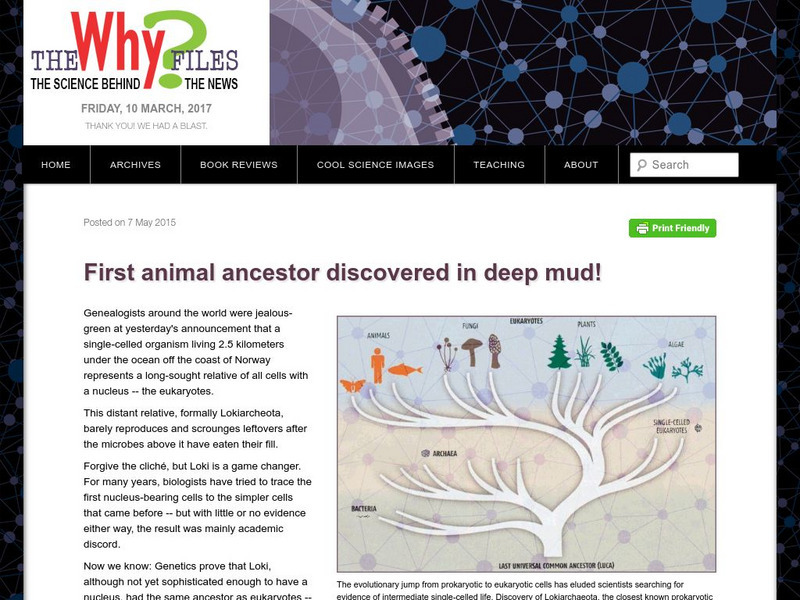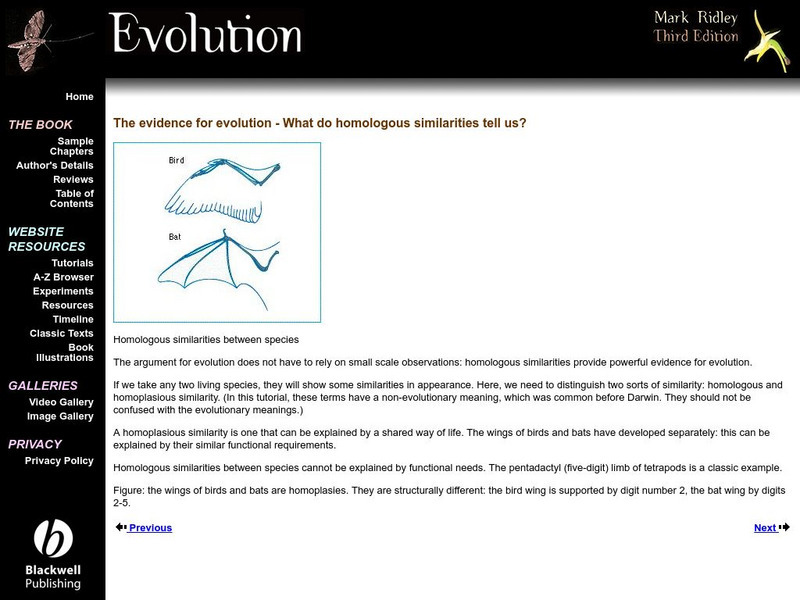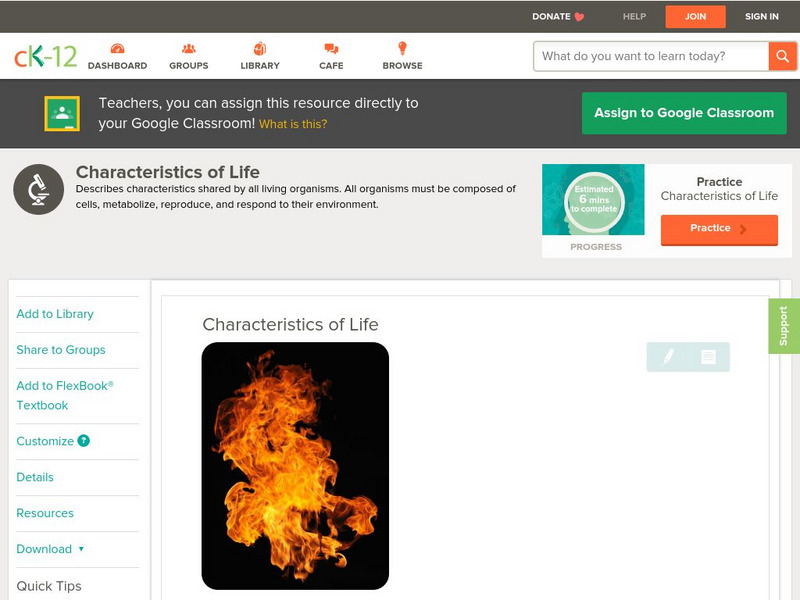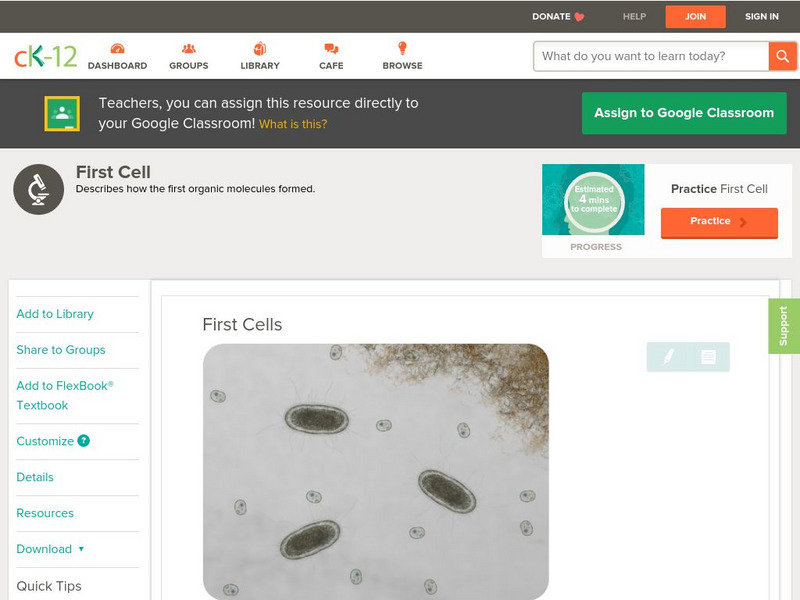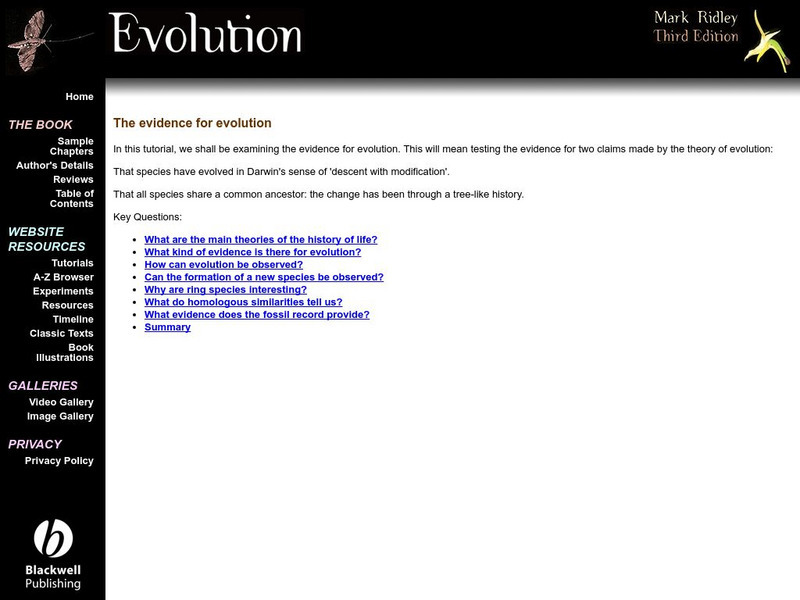The Wonder of Science
The Wonder of Science: Ms Ls4 3: Embryological Evidence of Common Ancestry
Work samples, phenomena, assessment templates, and videos that directly address standard MS-LS4-3: embryological evidence of common ancestry.
University of Wisconsin
The Why Files: First Animal Ancestor Discovered in Deep Mud
Two billion years ago, we share a common ancestor with this new-found relative. Is this our origin?
Cold Spring Harbor Laboratory
Dna From the Beginning: Living Things Share Common Genes
This multimedia article includes animations, pictures, video, biographical information, and quiz questions that are accessed by clicking on buttons along the bottom of the page. Here you can see how common genes are evidence for common...
The Wonder of Science
The Wonder of Science:ms Ls4 1: Fossil Evidence of Common Ancestry and Diversity
Students analyze and interpret data for patterns in the fossil record that document the existence, diversity, extinction, and change of life forms throughout the history of life on earth under the assumption that natural laws operate...
University of California
University of California Museum of Paleontology: Homologies
These pages are from the Understanding Evolution website for teachers. They focus on homologous structures that organisms with common ancestors share.
Other
Evidence for Evolution: Genetic Code
These pages are part of a site called Evolution that accompany a textbook by the same name. Mark Ridley is the author. In this section: the universal genetic code provides evidence that life has a common ancestor.
PBS
Pbs News Hour Extra: Scientists Discover Oldest Human Ancestor
Scientists have recently published their research into fossil bones from Ethiopia that they say came from an ancestor common to both humans and chimpanzees. They have named the ancestor Ardipithecus ramidus. In the articles and video,...
National Health Museum
Access Excellence: Molecular Biology/primate Phylogeny
This lesson plan involves comparison of amino acids to create a phylogenetic tree of primates. Young scholars will also use other species information to draw conclusions about evolutionary relationships.
Other
The Evidence for Evolution: Homologous Similarities
This site is a section part of a website that accompanies "Evolution," a textbook by Mark Ridley. Here he covers homologous structures, using them as evidence for evolution.
Other
Evolution: Evidence From Living Organisms
By examining fossils, scientists have collected evidence that supports the theory that species changed over time. As you read this article, study this evidence and critically evaluate whether it indicates that species may have arisen by...
University of California
University of California Museum of Paleontology: Similarities and Differences
A module explaining how two different organisms can possess similar traits by sharing a common ancestor(homology) or due to convergent evolution(analogy).
Khan Academy
Khan Academy: Answers to Exploration Questions: What Is a Dinosaur?
Do you know what a dinosaur is? This site has answers to the exploration questions about dinosaurs and a common ancestors.
CommonLit
Common Lit: Text Sets: Immigration
This is a collection of 24 Grade-Leveled texts (5-11) on the topic of Immigration. Most Americans can trace their ancestry back to immigrants coming to the New World. Learn about America's history of immigration, particularly during the...
CommonLit
Common Lit: Book Pairings: "Farewell to Manzanar" by Jeanne Wakatsuki Houston
Selected (7) reading passages (grades 8-11) to pair with the memoir "Farewell to Manzanar" by Jeanne Wakatsuki. [Free account registration required for specific tools.]
Other
Bringing History Home: Immigration History
This 2nd grade unit invites children to learn their ancestors' native countries of origin. The take-home page for family ancestry offers several alternatives to citing a specific family immigration history. Studying immigration provides...
CK-12 Foundation
Ck 12: Life Science: Characteristics of Life
[Free Registration/Login may be required to access all resource tools.] How do you define a living thing? What do mushrooms, daisies, cats, and bacteria have in common? All of these are living things, or organisms. It might seem hard to...
National Health Museum
Access Excellence: Making a Phylogenetic Tree Lesson Plan
Constructing phylogenetic trees may be a daunting task for students, but this lesson plan is a simulation of what molecular biologists must do to determine relationships. This plan is for students who have a good grasp of DNA structure...
CK-12 Foundation
Ck 12: Biology: First Cells
[Free Registration/Login may be required to access all resource tools.] Describes the first cells and the evolution of photosynthesis and cellular respiration.
Other
The Evidence for Evolution
These pages are part of a site called "Evolution," that accompanies a textbook by the same name. Mark Ridley is the author, and in this section he discusses the evidence for evolution.
Curated OER
Educational Technology Clearinghouse: Clip Art Etc: Charles Darwin
An English naturalist who established that all species of life have descended over time from common ancestry. He proposed the theory of natural selection and evolution.
Curated OER
Black Hills Institute of Geological Research, Inc.: Ammonoids
This is an Ammonoid, more commonly referred to as an Ammonite, an extinct ancestor of today's octopus, squid and nautilus.

